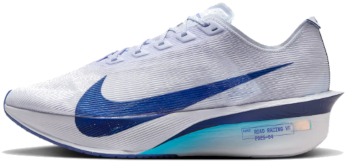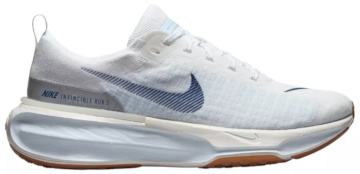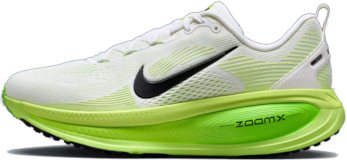Finding the right pair of Nike running shoes can completely change how you feel on the road, whether you’re chasing a new PR or just easing into a fitness routine. With so many models, foams, and features to choose from, it’s easy to feel overwhelmed by the options. But understanding what your feet need, and how each shoe is built to perform, can make the decision much simpler.
In this guide, we’ll break down the essentials: your foot type, how you run, the terrain you train on, and the fit and feel you personally prefer. Whether you’re a longtime marathoner or someone lacing up for the first time, these insights will help you zero in on the perfect pair. The goal is simple: find the Nike shoe that matches your stride, supports your goals, and makes every run feel better than the last.
Table of Contents
- Understanding Your Running Style
- Types of Nike Running Shoes
- Key Features to Consider
- Comparison of Popular Nike Models
- Finding the Right Fit
- Maintaining Your Nike Running Shoes
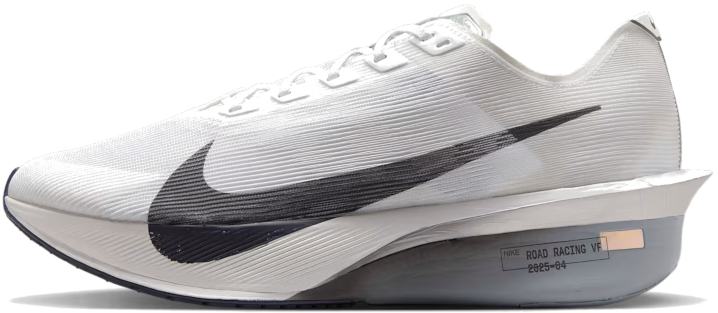
Understanding Your Running Style
Different Running Styles Explained
Running styles can be categorized into four main types:
- Forefoot Running: This style involves landing on the forefoot, which can help absorb impact better and facilitate a quicker stride. It’s common among sprinters and those who prioritize speed.
- Midfoot Running: In this style, runners land on the midfoot, distributing weight evenly across the foot. It offers a balance of efficiency and impact absorption, making it popular among distance runners.
- Heel Striking: This style features landing on the heel first, which is common among casual runners. While it can lead to higher impact forces on the joints, many runners find it comfortable.
- Chi Running: This technique focuses on posture, relaxation, and efficient movement. It encourages a midfoot strike while promoting a forward lean to reduce strain and improve endurance.
Each running style has its benefits and drawbacks, and choosing the right one often depends on personal comfort, running goals, and body mechanics.
How to Determine Your Running Style
To determine your running style, follow these steps:
- Observe Your Feet: Look at the wear patterns on your running shoes. Check if the outer edges are worn down (indicative of supination), the inner edges (suggesting pronation), or if the wear is even (neutral).
- Video Analysis: Record yourself running on a treadmill or flat surface from the side. Analyze your foot strike (heel, midfoot, or forefoot) and observe your knee and hip alignment.
- Consult a Professional: Visit a running store or a sports clinic that offers gait analysis. They can provide insights based on specialized equipment and expertise.
- Self-Assessment: Pay attention to how your body feels during and after runs. Note any discomfort in your feet, knees, or hips, which can indicate your running style.
- Try Different Shoes: Experiment with different types of running shoes designed for specific styles (neutral, stability, or motion control). See which feels most comfortable and supports your form best.
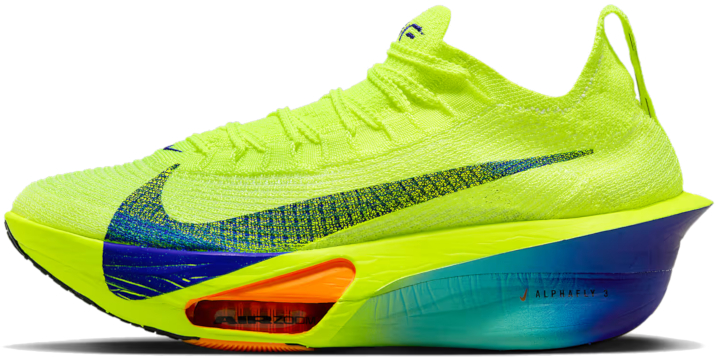
Types of Nike Running Shoes
Neutral Running Shoes
Neutral running shoes are designed for runners with a natural gait who do not require extra support for overpronation or underpronation. These shoes provide cushioning and flexibility, allowing for a smooth transition from heel to toe.
They typically feature a balanced outsole and midsole, promoting an even distribution of impact forces. Neutral running shoes are ideal for those who have a neutral foot strike and seek comfort during their running activities.
Stability Running Shoes
Stability running shoes are designed to provide support and cushioning for runners who overpronate, or whose feet roll inward excessively during their stride. These shoes feature a combination of cushioning and firmer foam or materials on the inner side to help stabilize the foot and promote a more neutral gait.
Stability shoes typically offer a moderate level of arch support and are ideal for runners seeking a balance between support and comfort, helping to reduce the risk of injuries associated with overpronation.
Trail Running Shoes
Trail running shoes are specialized footwear designed for off-road running on varied terrain such as trails, dirt paths, and rocky surfaces. They typically feature aggressive tread patterns for enhanced grip, increased cushioning for shock absorption, and durable materials to withstand rough conditions.
Many models also offer water resistance and protective features to safeguard against debris and uneven surfaces. Trail running shoes provide stability and traction, making them ideal for runners seeking adventure in natural settings.
Minimalist Running Shoes
Minimalist running shoes are footwear designed to provide a lightweight, flexible experience that encourages a natural running style. They typically have a low heel-to-toe drop, minimal cushioning, and a wider toe box to allow for natural foot movement.
The goal is to promote a more efficient running form and strengthen foot muscles by mimicking barefoot running conditions. Minimalist shoes often feature breathable materials and a durable outsole for traction, appealing to runners seeking a closer connection to the ground.
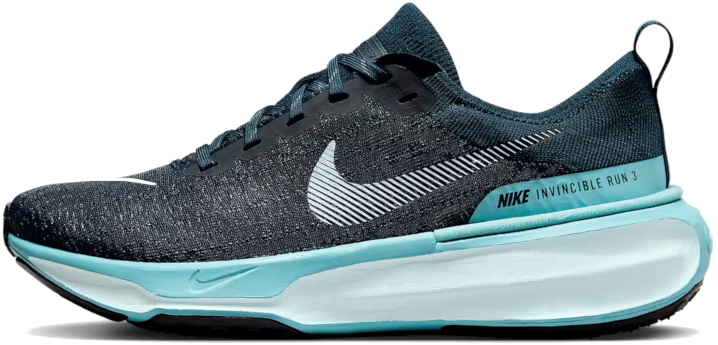
Perfect Nike Running Shoes: Key Features to Consider
Cushioning Options
When choosing the perfect Nike running shoes, consider your cushioning options carefully. Look for shoes that offer:
- Foam Type: Evaluate the type of foam used, such as ZoomX or React, which provide varying levels of responsiveness and comfort.
- Cushioning Level: Determine if you prefer soft cushioning for a plush feel or firmer cushioning for stability and responsiveness.
- Drop Height: Analyze the drop height (heel-to-toe) to see how it affects your running posture and comfort.
- Foot Type: Consider your foot type (neutral, overpronation, or underpronation) to ensure the cushioning supports your specific needs.
- Running Distance: Match the cushioning to your running distance; longer runs may benefit from more cushioning, while shorter runs might not require as much.
- Terrain: Think about the terrain you’ll be running on; trail shoes may have different cushioning compared to road running shoes.
Test different models to find the right balance of cushioning that feels comfortable and supportive for your runs.
Support and Stability
When choosing the perfect Nike running shoes, consider the following support and stability options:
- Arch Support: Identify your arch type (neutral, low, or high) and select shoes designed for your specific needs to enhance comfort and performance.
- Cushioning: Look for models with the appropriate level of cushioning, which can help absorb impact and provide a smoother ride.
- Stability Features: For runners who overpronate, choose shoes with built-in stability features like medial posts or firmer foam to help correct foot motion.
- Fit and Lockdown: Ensure the shoe fits snugly around the heel and midfoot while allowing room in the toe box to prevent blisters during runs.
- Terrain Considerations: Select shoes designed for the type of running you’ll be doing (road, trail, or track) as they offer different levels of support and traction.
- Test Runs: Always try on shoes and go for a short run to assess their support, comfort, and stability under actual running conditions.
- Consultation: Consider visiting a specialty running store for a gait analysis to receive personalized recommendations based on your running style.
By evaluating these factors, you can make an informed decision on the best Nike running shoes for your needs.
Weight and Breathability
When choosing the perfect Nike running shoes, consider the following factors regarding weight and breathability:
- Weight: Look for lightweight materials that enhance speed and reduce fatigue during long runs. Shoes designed for racing typically have a lower weight compared to training shoes, making them ideal for competitive runners.
- Breathability: Choose shoes with mesh uppers or engineered ventilation to promote airflow. This helps keep your feet cool and dry, preventing discomfort and blisters during intense workouts.
- Cushioning vs. Weight: Balance cushioning with weight. Shoes with more cushioning may add weight but provide better shock absorption and comfort. Opt for a model that offers sufficient cushioning without significantly increasing weight.
- Running Surface: Consider the terrain you’ll be running on. Trail shoes may be heavier and more durable, while road shoes focus on lightweight and breathable designs for pavement running.
- Fit and Comfort: Ensure the shoe fits well and is comfortable. A snug fit with breathable materials will enhance performance and prevent foot fatigue.
Evaluate these aspects to find a Nike running shoe that meets your specific needs and running style.
Durability and Material
When choosing the perfect Nike running shoes, consider the following durability and material options:
- Upper Materials: Look for breathable mesh or engineered knit for lightweight comfort. Synthetic overlays can provide added support and durability.
- Midsole Cushioning: Choose shoes with durable foam materials like Nike React or ZoomX for optimal responsiveness and longevity.
- Outsole Composition: Examine the outsole material; rubber compounds offer traction and durability, while carbon rubber provides extra resistance to wear.
- Water Resistance: Consider shoes with water-repellent materials if running in wet conditions, ensuring they maintain performance and comfort.
- Weight vs. Durability: Balance lightweight designs with robust construction; lighter shoes may wear out faster, while heavier models often provide more support.
- Shoe Type: Select the right shoe type (neutral, stability, or motion control) based on your foot’s needs to enhance durability and performance.
Evaluate these factors to find a pair that meets both your performance needs and durability expectations.
Comparison of Popular Nike Models
Nike Pegasus 41
The Nike Pegasus 41 stands out from other Nike running shoes through its advanced cushioning system, offering a balance of responsiveness and comfort. Many experts consider it the best Nike running shoe.
The Peg 41 features an updated Flyknit upper for improved breathability and a snug fit, enhancing overall support during runs. The shoe incorporates a ReactX foam midsole, which provides superior energy return compared to traditional foams. Additionally, the outsole is designed with a unique traction pattern, allowing for better grip on various surfaces.
Nike Vaporfly 4
The Nike Vaporfly 4 features several key differences compared to other Nike running shoes. Many experts consider it the best Nike shoe for racing because of its focus on speed and performance.
The Nike Vaporfly 4 incorporates a full-length carbon fiber plate that provides propulsion and enhances energy return, which is not present in most standard Nike running shoes. It utilizes ZoomX foam, offering superior cushioning and lightweight properties, significantly improving responsiveness and comfort during runs.
The shoe’s unique rocket-last design promotes a forward-leaning position, optimizing running efficiency and speed. It uses a breathable, lightweight mesh upper designed for optimal fit and ventilation, differing from the materials used in other models. The stack height is higher compared to traditional running shoes, providing additional cushioning and support for long-distance racing. Additionally, it is constructed to be lighter than many other Nike running shoes, aiding in speed and performance.
Nike Alphafly 3
The Nike Alphafly 3 stands out from other Nike running shoes due to its unique combination of advanced technologies and design features. Many experts consider it the best Nike running shoe for marathon competition.
The Nike Alphafly 3 incorporates the ZoomX foam, which offers superior energy return and cushioning, making it ideal for long-distance running. It features a carbon-fiber plate that enhances propulsion and stability, setting it apart from models that rely solely on traditional cushioning.
Additionally, the Alphafly 3 has a lightweight mesh upper that provides breathability and a secure fit, which differs from the heavier materials used in other Nike options. Its unique outsole design allows for better traction and grip on various surfaces, further distinguishing it from competitors within Nike’s running lineup.
Nike Invincible 3
The Nike Invincible 3 separates itself from the rest of Nike’s lineup by leaning fully into cushioning and comfort, more than any other shoe the brand makes. Many runners and reviewers consider it Nike’s most comfortable model, and it’s easy to see why. The ZoomX foam delivers an ultra-soft, springy ride that feels noticeably more forgiving than the cushioning found in most daily trainers. Pair that with a wider base, and you get a shoe that feels both plush underfoot and surprisingly stable for its stack height.
What really rounds out the Invincible 3’s personality is its bouncy ride, smooth rocker design, and breathable upper. The rocker helps you roll from heel to toe with less effort, giving each stride a fluid, easygoing feel that’s different from Nike shoes built primarily for speed. Meanwhile, the airy upper keeps things cool and secure without squeezing the foot. Altogether, it’s a standout option for runners who want maximum comfort, reliable support, and a ride that feels effortless from start to finish.
SHOP AT DICK’SNike Vomero 18
The Nike Vomero 18 differs from other Nike running shoes in several key ways. Many experts consider it the most cushioned Nike running shoe.
The Nike Vomero 18 features a uniquely cushioned midsole with a lightweight ZoomX foam on top of the ReactX foam for enhanced speed, energy return, and comfort. The shoe incorporates a breathable mesh upper that provides targeted support while maintaining ventilation.
It also utilizes a more pronounced rocker shape for smoother transitions during runs. Additionally, the Vomero 18 offers a wider toe box compared to other Nike models, catering to runners seeking extra space and comfort.
Perfect Nike Running Shoes: Finding the Right Fit
Importance of Proper Fit
Proper fit in running shoes is crucial for performance and injury prevention. A well-fitting shoe provides adequate support, stability, and comfort, allowing runners to maintain optimal form. Shoes that are too tight can cause blisters and discomfort, while those that are too loose may lead to instability and potential injuries.
Proper fit also accommodates foot shape, arch type, and running style, enhancing overall efficiency. Additionally, runners should always try on shoes at the end of the day, when feet are slightly swollen, and ensure there is enough room in the toe box for natural movement.
Measuring Your Feet
To measure your feet for running shoes, follow these steps:
- Gather Materials: You will need a piece of paper, a pencil, and a ruler or measuring tape.
- Prepare the Paper: Place the paper on a flat surface. Stand on the paper with your heel against the wall.
- Trace Your Foot: While standing, trace around your foot with the pencil, keeping the pencil vertical. Make sure to capture the outline accurately.
- Measure Length: Use the ruler to measure the distance from the heel to the longest toe. Record this measurement in inches or centimeters.
- Measure Width: Measure the widest part of your foot, usually across the ball. Record this measurement as well.
- Repeat: Repeat the process for your other foot, as they may differ in size.
- Consult Size Charts: Compare your measurements with the shoe brand’s size chart to determine your shoe size.
- Consider Fit Preferences: Keep in mind that some runners prefer a snug fit, while others like a bit more room.
- Try Shoes On: If possible, try on shoes later in the day when your feet are slightly swollen for a more accurate fit.
Trying on Shoes: What to Look For
When trying on shoes, follow these steps:
- Check the Size: Ensure you’re wearing the right size. Stand up and make sure there’s about a thumb’s width of space between your longest toe and the front of the shoe.
- Fit and Comfort: Walk around in the shoes. They should feel comfortable right away, without pinching or excessive tightness.
- Arch Support: Assess if the shoes provide adequate support for your arch. If you have flat feet or high arches, choose accordingly.
- Heel Fit: The heel should fit snugly without slipping. If the heel slips, the shoes may be too big.
- Flexibility: Bend the shoe to see if it flexes at the ball of the foot. It should move with your foot.
- Width: Ensure the shoe isn’t too narrow or wide. Your foot should not spill over the sides.
- Try with Socks: Wear the type of socks you plan to use with the shoes when trying them on.
- Surface Test: Walk on different surfaces if possible (carpet, tile) to see how the shoe feels.
- Look for Quality: Inspect the shoe for quality stitching, materials, and overall construction.
- Time of Day: Try shoes later in the day when your feet may be slightly swollen to get a more accurate fit.
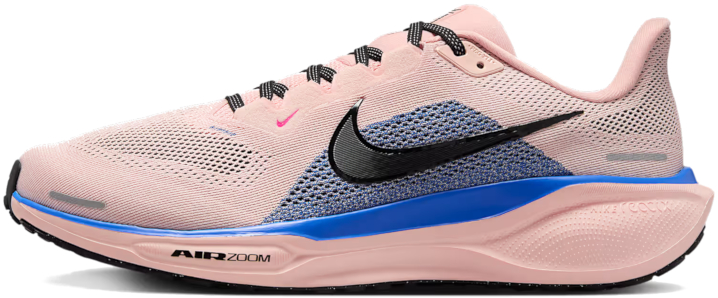
Maintaining Your Nike Running Shoes
Cleaning and Care Tips
Here’s how to clean and care for your running shoes:
- Remove Laces and Insoles: Take out the laces and insoles to clean them separately.
- Brush Off Dirt: Use a soft brush or cloth to remove loose dirt and debris from the shoe’s surface.
- Prepare Cleaning Solution: Mix mild detergent with warm water. Avoid harsh chemicals.
- Clean the Shoes: Dip a cloth or soft brush into the solution and gently scrub the shoes, focusing on stained areas.
- Rinse with Water: Wipe the shoes with a damp cloth to remove soap. Avoid soaking them.
- Dry Properly: Air dry the shoes at room temperature away from direct sunlight or heat sources.
- Lace and Insole Care: Wash laces in soap and water, then air dry. Clean insoles as needed; if they’re too worn, consider replacing them.
- Store Wisely: Keep shoes in a cool, dry place. Use a shoe tree or stuff them with newspaper to maintain shape.
- Rotate Shoes: Alternate between pairs to extend their lifespan and allow for proper drying.
When to Replace Your Shoes
Replace your running shoes every 300 to 500 miles, depending on your running style, body weight, and the shoe type. Look for signs of wear such as decreased cushioning, uneven tread wear, and visible damage. If you experience discomfort or pain during runs, it may be time for a replacement. Regularly assess your shoes after long runs or races, and consider replacing them if you notice any of these indicators.
Final Thoughts on Perfect Nike Running Shoes
In conclusion, selecting the perfect pair of Nike running shoes is an essential step towards enhancing your running experience. By understanding the key factors outlined in this guide, such as your running style, foot type, and the specific features of different Nike models, you can make an informed decision that aligns with your unique needs.
Investing time in this process not only ensures comfort and support but also maximizes your performance, allowing you to enjoy each run to the fullest. Whether you’re a seasoned marathoner or just starting your fitness journey, the right pair of Nike shoes can make all the difference.
Take the insights from this guide and step confidently into your next run, knowing you’ve chosen the perfect footwear to support your goals.
Heads up: As an Amazon Associate, we earn from qualifying purchases. (This content was created with the help of AI.)
You may also like:


